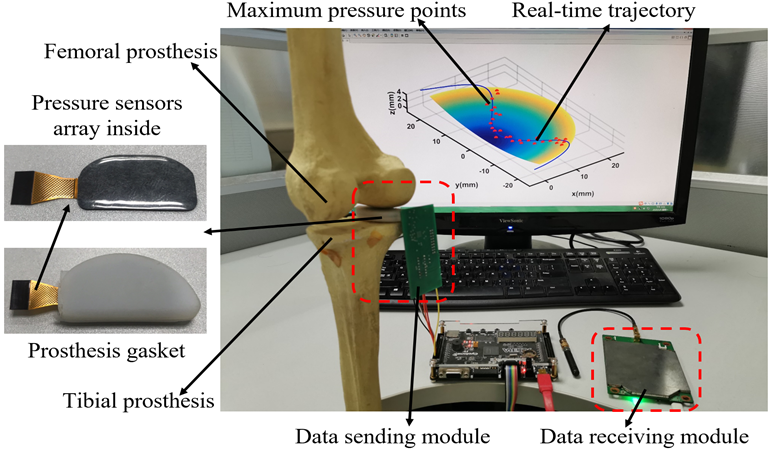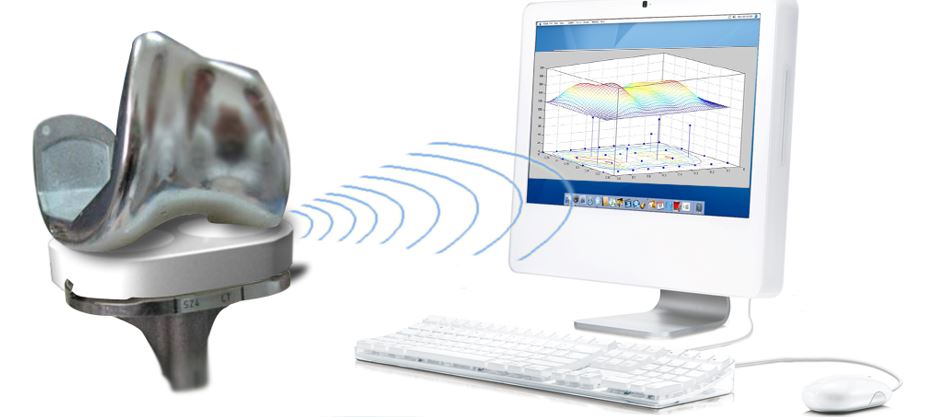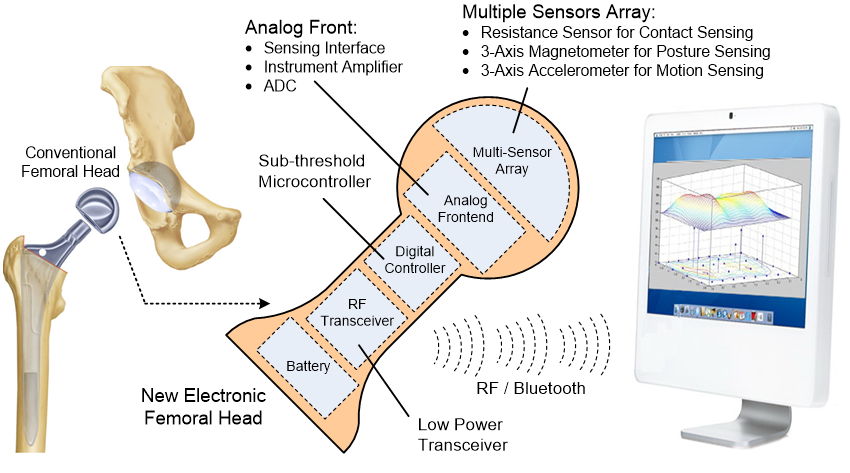An IMU-Based Real-Time Measuring System for Acetabular Prosthesis Implant Angles in THR Surgeries
With the aging of population, the number of total hip replacement (THR) surgeries increases year by year. To improve the success rate of THR operation, the measurement of acetabular prosthesis angles should be precise during the surgery. We design an inertial measurement unit based real-time measurement system, which measures the initial attitude of the pelvis coordinate, and traces the real-time attitude of the pelvis coordinate and prosthesis axis. By collecting real-time data of diff- erent pelvic and prosthesis attitudes in quaternion representation through accelerometers and gyroscopes, the relative position between pelvis and prosthesis is calculated in real time. An optimized algorithm is proposed to obtain prosthesis implant angles accurately from the data. The experimental results show that the measured implant angles agree with that calculated by radiographic value, the root mean square errors (RMSE) are less than 3.52 degrees, which is within the safe range of THR requirement. Furthermore, no matter how the implant angles change, the measured values agree with reference values, the RMSE is less than 3.27 degrees. The experimental results show that our system can trace the real-time dislocation of the prosthesis during the THR surgeries.

A Wireless Trajectory Measurement System for Unicondylar Knee Arthroplasty
During unicondylar knee arthroplasty surgery, the tibial prosthesis is fixed and the angle of distal femoral prosthesis relative to the prosthetic gasket is changed to generate the force line trajectory, which is important for doctors to judge the appropriate position of the implants. In this article, we propose a wireless force line trajectory measurement system for unicondylar knee arthroplasty, which includes the pressure sensors array, the control and processing data circuits, the radio frequency transmitter, and the data recorder. Data from 20 sensors are processed and transmitted wirelessly, and the force line trajectory is displayed on the screen in real time. The least squares fitting algorithm is proposed, with which we obtain the pressure distribution, the maximum pressure points, and the force line trajectory. We adopt field programmable gate array to implement the algorithm with lower–upper decomposition to fit the trajectory faster and transmit less data to save power. The average current consumption of the system is 1.37 mA in the operating mode. Dimensions of the data transmission module are length 70 mm, width 35 mm, and height 4 mm. The total uncertainty of the system measurement force line trajectory is 0.92 mm. Experimental results show that the system meets the requirement of real-time measurement of the force line trajectory during the surgery. Index Terms— Force line trajectory measurement, least squares fitting, lower–upper decomposition, transmitted wirelessly, unicondylar knee arthroplasty.

Low-Power Circuits for the Bidirectional Wireless Monitoring System of the Orthopedic Implants
This paper proposes an architecture of the wireless monitoring system for the real-time monitoring of the orthopedic implants, which monitors the implant duty cycle, detects abnormal asymmetry, high amounts of force, and other conditions of the orthopedic implants. Data for diagnosis are communicated wirelessly by the radio-frequency (RF) signal between the embedded chip and the remote circuit. In different working modes, the system can be powered by the RF signal or stiff lead zirconate–titanate (PZT) ceramics which are able to convert mechanical energy inside the orthopedic implant into electrical energy. The power circuits with a variable ratio switched-capacitor (SC) dc–dc converter have been taped out with 0.35- m complementary metal–oxide semiconductor (CMOS) technology. The test results show that the SC converter can transfer the input voltage that ranges from 5 V to 14 V from the PZT ceramics into the voltage ranging from 2 V to 2.5 V which will be dealt with by a low drop-out circuit in the future work. The total efficiency of the SC converter is from 28% to 42% at full-time working mode. The analog-to-digital converter (ADC) circuits have been fabricated in a 0.18- m 1P6M CMOS process. The test results show that the ADC chip consumes only 12.5 W in working mode and 150 nW in the sleep mode. The circuits, including RF circuits, ADC, and the microcontrol unit, have been implemented in a 0.18- m CMOS process. Future work includes some clinical experiments test in the application where PZT elements are use.

System for Prosthesis Pose Estimation During Total Hip Replacement Surgery
The average age of population increases worldwide, so does the number of total hip replacement surgeries. Total hip replacement, however, often involves a risk of dislocation and prosthetic impingement. To minimize the risk after surgery, we propose an instrumented hip prosthesis that estimates the relative pose between prostheses intraoperatively and ensures the placement of prostheses within a safe zone. We create a model of the hip prosthesis as a ball and socket joint, which has four degrees of freedom (DOFs), including 3-DOF rotation and 1-DOF translation. We mount a camera and an inertial measurement unit (IMU) inside the hollow ball, or “femoral head prosthesis,” while printing customized patterns on the internal surface of the socket, or “acetabular cup.” Since the sensors were rigidly fixed to the femoral head prosthesis, measuring its motions poses a sensor ego-motion estimation problem. By matching feature points in images of the reference patterns, we propose a monocular vision based method with a relative error of less than 7% in the 3-DOF rotation and 8% in the 1-DOF translation. Further, to reduce system power consumption, we apply the IMU with its data fused by an extended Kalman filter to replace the camera in the 3-DOF rotation estimation, which yields a less than 4.8% relative error and a 21.6% decrease in power consumption. Experimental results show that the best approach to prosthesis pose estimation is a combination of monocular vision-based translation estimation and IMU-based rotation estimation, and we have verified the feasibility and validity of this system in prosthesis pose estimation





